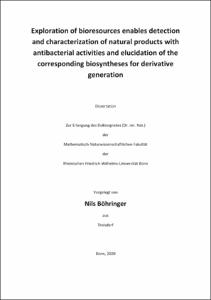Böhringer, Nils: Exploration of bioresources enables detection and characterization of natural products with antibacterial activities and elucidation of the corresponding biosyntheses for derivative generation. - Bonn, 2021. - Dissertation, Rheinische Friedrich-Wilhelms-Universität Bonn.
Online-Ausgabe in bonndoc: https://nbn-resolving.org/urn:nbn:de:hbz:5-64461
Online-Ausgabe in bonndoc: https://nbn-resolving.org/urn:nbn:de:hbz:5-64461
@phdthesis{handle:20.500.11811/9408,
urn: https://nbn-resolving.org/urn:nbn:de:hbz:5-64461,
author = {{Nils Böhringer}},
title = {Exploration of bioresources enables detection and characterization of natural products with antibacterial activities and elucidation of the corresponding biosyntheses for derivative generation},
school = {Rheinische Friedrich-Wilhelms-Universität Bonn},
year = 2021,
month = nov,
note = {The discovery of antibiotics in the early 20th century sparked a medicinal revolution, which for the first time in history enabled humankind to effectively combat bacterial infections. Despite this immense success, the discovery and development of novel antibiotics dwindled over the decades, while resistances against all clinically relevant antibiotics arose and spread. This is of major concern, since this impedes successful treatment of bacterial infections. Especially gram – negative bacterial pathogens which acquired resistances against clinically relevant antibiotics represent a major threat to global human health. Hence, the discovery and development of new efficacious antibiotics against these pathogens is of great importance. In this thesis, three projects that contributed to the discovery and investigation of novel antibacterial natural products are described.
Through the seeming depletion of terrestrial bioresources, especially actinobacterial environmental isolates, other resources such as marine habitats moved into focus. Chapter I describes the investigation of nudibranchia associated bacteria around Bunaken Island, Indonesia, in respect to their ability to synthesise antibacterial natural products. Here, 49 bacterial strains were isolated and their potential for production of antibacterial natural products was investigated.
In chapter II, the biosynthesis of the streptomycetal antibacterial natural product pseudouridimycin was investigated. Based on previous work by Sosio et al., the biosynthetic gene cluster was rearranged and overexpressed in Streptomyces coelicolor M1146. In total, three versions of the BGC were cloned, which enabled detection of the minimal pseudouridimycin biosynthetic gene cluster.
Chapter III describes the investigation of the novel antibacterial compound Darobactin. Due to its novel mode of action, inhibiting the outer membrane chaperone BamA, Darobactin is only effective against gram – negative bacteria. This is especially interesting in respect to the particular threat that resistant gram – negative pathogens pose. The underlying biosynthetic gene cluster was identified and its involvement in Darobactin formation corroborated. This allowed identification and initial characterisation of more Darobactin derivatives.},
url = {https://hdl.handle.net/20.500.11811/9408}
}
urn: https://nbn-resolving.org/urn:nbn:de:hbz:5-64461,
author = {{Nils Böhringer}},
title = {Exploration of bioresources enables detection and characterization of natural products with antibacterial activities and elucidation of the corresponding biosyntheses for derivative generation},
school = {Rheinische Friedrich-Wilhelms-Universität Bonn},
year = 2021,
month = nov,
note = {The discovery of antibiotics in the early 20th century sparked a medicinal revolution, which for the first time in history enabled humankind to effectively combat bacterial infections. Despite this immense success, the discovery and development of novel antibiotics dwindled over the decades, while resistances against all clinically relevant antibiotics arose and spread. This is of major concern, since this impedes successful treatment of bacterial infections. Especially gram – negative bacterial pathogens which acquired resistances against clinically relevant antibiotics represent a major threat to global human health. Hence, the discovery and development of new efficacious antibiotics against these pathogens is of great importance. In this thesis, three projects that contributed to the discovery and investigation of novel antibacterial natural products are described.
Through the seeming depletion of terrestrial bioresources, especially actinobacterial environmental isolates, other resources such as marine habitats moved into focus. Chapter I describes the investigation of nudibranchia associated bacteria around Bunaken Island, Indonesia, in respect to their ability to synthesise antibacterial natural products. Here, 49 bacterial strains were isolated and their potential for production of antibacterial natural products was investigated.
In chapter II, the biosynthesis of the streptomycetal antibacterial natural product pseudouridimycin was investigated. Based on previous work by Sosio et al., the biosynthetic gene cluster was rearranged and overexpressed in Streptomyces coelicolor M1146. In total, three versions of the BGC were cloned, which enabled detection of the minimal pseudouridimycin biosynthetic gene cluster.
Chapter III describes the investigation of the novel antibacterial compound Darobactin. Due to its novel mode of action, inhibiting the outer membrane chaperone BamA, Darobactin is only effective against gram – negative bacteria. This is especially interesting in respect to the particular threat that resistant gram – negative pathogens pose. The underlying biosynthetic gene cluster was identified and its involvement in Darobactin formation corroborated. This allowed identification and initial characterisation of more Darobactin derivatives.},
url = {https://hdl.handle.net/20.500.11811/9408}
}






